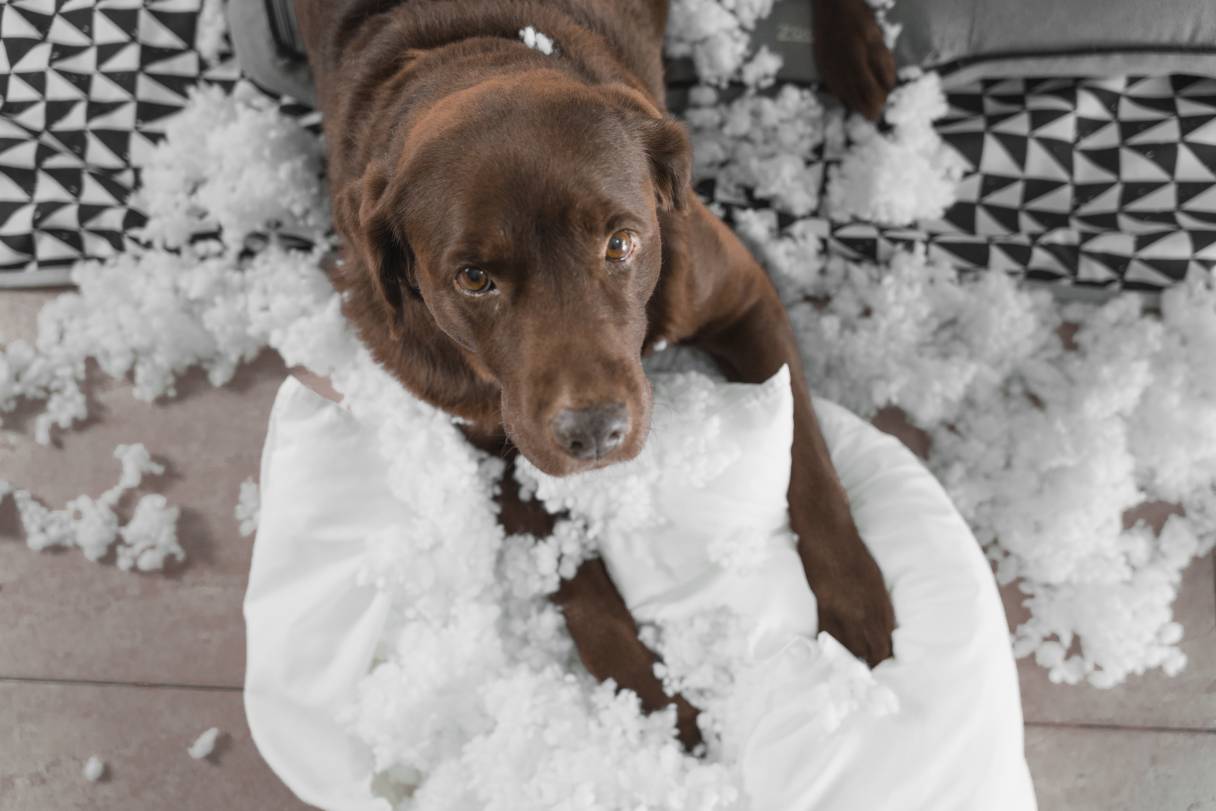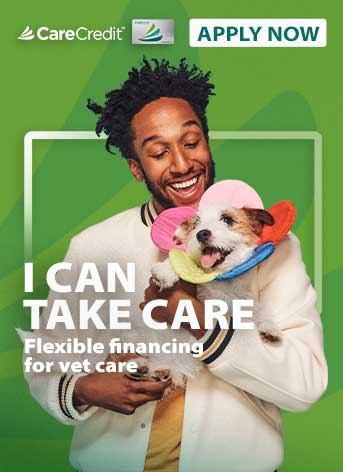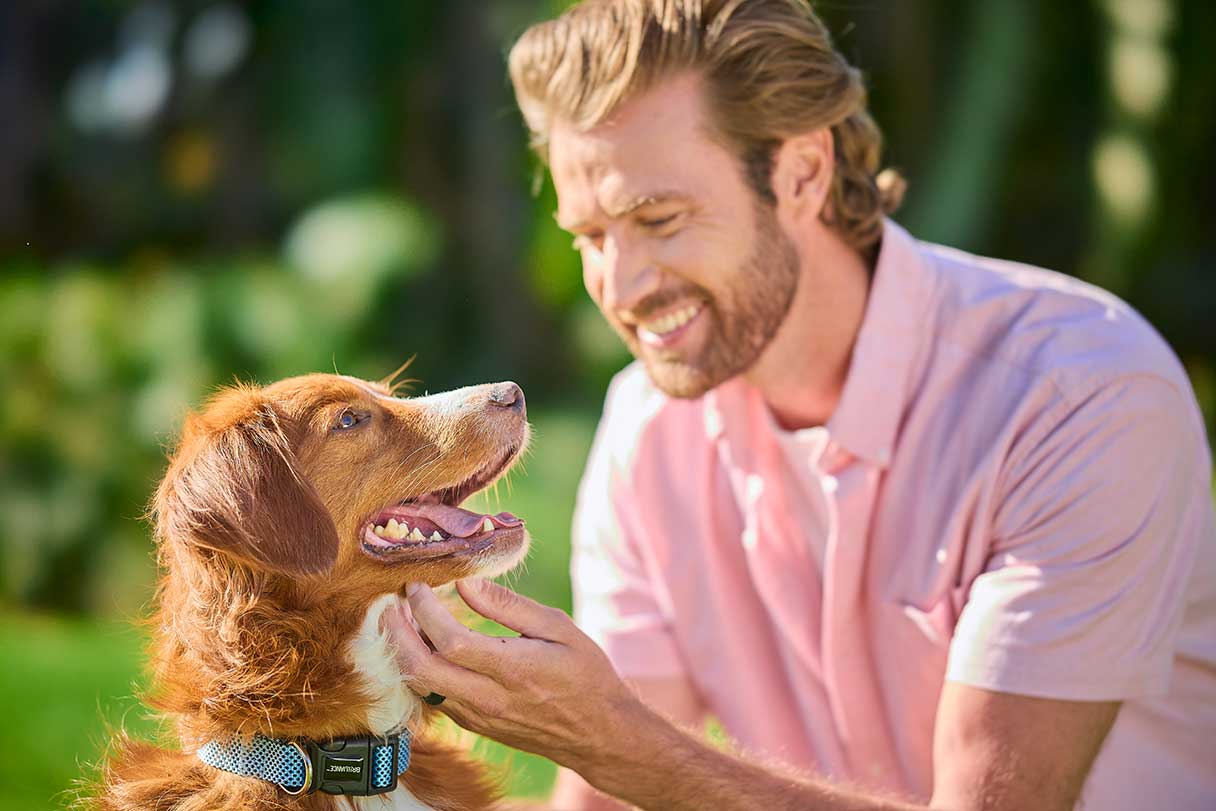No one likes saying goodbye to their dog, but if they go crazy whenever you leave the house to go to work or run errands, you could be dealing with separation anxiety. And you're not alone — around 76% of dogs in the United States experience some form of separation anxiety from their owners.1
While 69% of people would prefer to work from home to accommodate their dog's separation anxiety and 41% regularly change plans if their dog can't come along to an event, this isn't always practical.1
Below, we'll explore what separation anxiety is, why it happens and how you can help alleviate your dog's stress when you aren't with them 24/7.
What Is Separation Anxiety in Dogs?
Dogs with separation anxiety experience intense fear, similar to a panic attack in humans, when they are separated from an owner. This goes beyond the usual sadness that occurs with many dogs when an owner leaves the home — they become mildly sad but not stressed out and can calmly deal with the separation until the owner returns. Dogs with separation anxiety are typically attached to you at the hip when you're around and wildly destructive when you're not.2
Different types of separation anxiety
Not all dogs with separation anxiety experience the same level of distress when separated from their pet parents. Generally, separation anxiety is separated into three types:2
- Mild, also known as separation intolerance3
- Moderate
- Severe
Generally, the more severe your dog's separation anxiety, the greater their reactions to your departure and the more destructive they will be. Those with severe separation anxiety may need medication along with training methods to overcome their severe panic when not by your side.
Common Causes of Separation Anxiety in Dogs
There are several potential causes of separation anxiety in dogs, usually related to some type of change in the household or a disruption to your dog's usual routine. These causes can include:2
1. New owner
If your dog has recently been adopted from a shelter or has been rehomed with a new owner, it could trigger separation anxiety. In fact, separation anxiety is more common in shelter dogs than those raised by one household since birth.
2. Moving homes
Simply relocating to a new home with your dog could trigger separation anxiety due to their new, unfamiliar surroundings.
3. Loss of a family member
When someone in your household has departed or passed away, your dog may develop separation anxiety as a result of their loss, especially if they were very close to that person.
4. Schedule changes
You may have gotten a different schedule due to a new job or maybe you used to work from home but now have returned to the office. This type of change can be jarring for your dog, who may develop separation anxiety as a result.
5. Traumatic events
Dogs who go through a traumatic event, such as experiencing a robbery without the owner present4 or even spending an extended time in a boarding kennel, can later experience separation anxiety.5
Symptoms of Separation Anxiety in Dogs
The mental anguish that separation anxiety causes for your dog will manifest itself through certain behaviors, usually destructive ones. While the occasional accident in the home or chewing of your favorite slipper won't indicate separation anxiety, if your dog exhibits several of these symptoms regularly, you're likely dealing with an anxious pup.
Symptoms of separation anxiety in dogs can include:2
- Eliminating in the home. While the occasional accident isn't anything to worry about, if your dog regularly eliminates in the home when you aren't there, it could indicate separation anxiety is at play.
- Excessive vocalization. Although some breeds love to bark, if your dog is regularly barking or howling all day only when you aren't around, it could indicate separation anxiety.
- Destructive behaviors. Your dog might be a little angel when you're by their side, but if — when you leave — they turn into a tiny terror and chew up your belongings or dig up your doorways, separation anxiety is likely to blame.
- Escape attempts. Your dog's attachment to you might be so great that when you aren't home, they will try desperately to escape and get to wherever you are. These destructive escape attempts might even result in self-harm for your dog, such as scraped paws and broken teeth.
- Pacing, whining or trembling. These behaviors will usually start right before you leave and continue while you are out of the home.4
- Drooling or panting. Anxious dogs will drool or pant when you aren't with them.4
- Eating feces (coprophagia). Dogs with separation anxiety may eat their own feces, but only when you aren't present.
- Refusal to eat. Dogs with severe separation anxiety may refuse to eat when you are away from home.3
Diagnosing Separation Anxiety in Dogs
For those who have noticed one or more of the behaviors associated with separation anxiety, visit a veterinarian to rule out an illness as the cause. That's because many of these behaviors can have a medical cause, such as a urinary tract infection,2 injury3 or vitamin deficiency.
After your veterinarian rules out a medical cause for your dog's behavior, they can consider the possibility of separation anxiety. One of the only definitive ways for your veterinarian to diagnose your dog with separation anxiety is to see video of your dog's behavior while you are out of the home.6
To do this:6
- Set up one or more video cameras in your home that are Wi-Fi accessible. Motion-activated cameras work best to capture behaviors such as pacing, inappropriate elimination and escape attempts or destructive chewing. These types of cameras cost between $30 and $210.7
- Leave your home as you normally would and use the cameras to not only monitor your dog from afar, but to record video of their behavior.
- Show your veterinarian a compilation of the videos on your phone or email your vet's office the video for them to observe.
- Let your veterinarian know if any of these behaviors occur when you are in the home or if they only occur when you are away.
Once your veterinarian has all of the facts and the video(s) to review, they can definitively tell you whether your dog suffers from separation anxiety or another form of anxiety, such as noise- or fear-based anxiety.
How to Help a Dog With Separation Anxiety
After bringing your dog to the vet to rule out a health condition and rule in separation anxiety as the cause of your dog's behavior, there are several ways you can treat it. Using these methods in combination with one another should help your dog overcome their anxiety.
Crate training
Your dog's crate can provide a cozy haven, helping them feel safe when they are alone. Crates average anywhere from $25 to $571, depending on their size and how elaborate they are.8
Train your dog to go into their crate when you feed them and give them their favorite chew toys and treats inside their crate. This will help them associate the crate with good things.4
While crate training can help some dogs with separation anxiety, others will panic while in the crate if you leave the home.4 This could lead them to harm themselves during an escape attempt from the crate. Use a video camera to observe them when they are in the crate to determine whether it's a help or a hindrance.
Counterconditioning
Dogs with separation anxiety associate your departure and absence with bad things. To help with this, you need counterconditioning of these responses by associating them with good things:2
- When leaving, give your dog a high-value treat, like peanut butter or cheese, in a chew toy for them to chew on for 20 minutes or more. Chew toys average in price between $7 and $20.9
- Feed them their kibble in a puzzle toy that will further occupy their time while you're away. Puzzle toys cost around $9 to $25.9
- Leave on the television or some calming soft rock or reggae music, and place some of your recently worn clothing in your dog's favorite area before you leave.5
- Use a treat-dispensing Wi-Fi video camera to reward your dog for good behavior and check in on them while you're out of the home.1 These types of cameras cost around $210.7
Through these counterconditioning measures, your dog will be occupied with pleasant things while you're away, easing their anxiety. Note that some dogs with severe separation anxiety may not respond to treats because they generally refuse to eat when you are away.
Desensitization
Many dogs begin to get anxious the moment you start to get ready in the morning, grab your breakfast and head for the door. They recognize these activities as cues that you are leaving. The key to dealing with this is to desensitize your dog to these cues and your departure:4
- Do things you would normally do before you leave, such as grabbing your car keys, but don't leave. And give them a treat.
- Get ready prior to leaving with your dog in their crate or a separate room if the crate makes them nervous.2
- Leave for small increments of time, returning before your dog's anxiety starts to amp up. Gradually extend this time each day.2
- Keep returns low-key by avoiding excitement when you walk in the door, instead doing your best to ignore your dog's enthusiastic greetings.4
Exercise
A lack of exercise is a major component in dogs with separation anxiety. After all, if your dog is dealing with a lot of pent-up and nervous energy, that can express itself in negative ways:2
- Help tire out your dog before you leave by giving them a vigorous exercise session of around 30 minutes. This will tire them out so they can relax while you're gone.
- Give your dog mental exercise in the form of basic obedience and trick training daily. Or, take your dog to a professionally run training class, which costs around $30 to $80 per session.10
- Provide your dog with plenty of interactive dog toys that will engage their brain while you're away. These types of toys cost between $10 to $50 or more.9
Calming aids for dogs
Along with crate training, counterconditioning, desensitization and exercise, you can use calming aids to soothe your dog while you're away. These aids include:11
- Calming treats that help relax your dog. The best calming treats contain ingredients like CBD, chamomile, passionflower, L-theanine, melatonin and L-tryptophan, and range in price from around $8 to $50.12
- Calming vests, which wrap around your dog and provide them with a sense of security, much like a hug. These vests range from around $10 to $70, based on the size of your dog.13
- Calming dog pheromones made from synthetic versions of the chemicals a female dog releases to calm her newborn puppies. You'll find these in the form of diffusers, sprays and pheromone-infused collars, all of which you can use together, if necessary. These types of products range in price from $12 to $50.14
- Comfy beds, where your dog can lay down and relax while you're away. Dog beds cost anywhere from $30 to $150 or more, based on the size and quality of the bed.15
Prescription medication
For dogs with severe separation anxiety, prescription medication can help them deal with being alone by keeping them calm. Your veterinarian can prescribe an anti-anxiety medication for your dog based on a diagnosis of separation anxiety.11
Anti-anxiety medications your vet may prescribe for dogs include:11
- Amitriptyline
- Fluoxetine
- Alprazolam
- Dexmedetomidine
- Buspirone
- Clomipramine
- Diazepam
These types of anti-anxiety medications will vary widely in price based on the dose your veterinarian recommends for your dog, but average from around $10 (for 30 pills) all the way up to over $200 or more (for 90 pills).16
Tips to Help Prevent Separation Anxiety in Dogs
There's no surefire way to completely prevent your dog's separation anxiety, as life isn't always as predictable as your dog — or you — might prefer. However, keeping a regular routine for your dog can go a long way toward preventing separation anxiety from developing because it gives your dog a sense of security.17
These tips may prevent your dog's anxiety from ramping up to harmful levels and even stop the anxiety in its tracks from becoming a bigger problem down the road. They can also help when combined with counterconditioning and desensitization:2
Bring your dog to daycare
Most dogs with separation anxiety will be happy if they aren't left alone during the day, and doggy daycare provides them with a place where that's never an issue. Plus, not only will they get to spend time with people, they can make some fellow canine friends as well and get lots of exercise, too. Expect to pay around $40 per day for doggy daycare.18
Use a dog walker
Some dogs will usually be able to handle being alone for smaller periods of time, such as a few hours, with counterconditioning and desensitization. But, leaving them by themselves for up to eight hours while you're at work could induce a panic attack.
Don't let that happen — have a dog walker stop by at least one to two times per day while you're at work. These breaks will provide your dog with the companionship they need to avoid stress and give them much-needed exercise. Expect to pay around $30 per visit for a 20-minute walk.19
Take your dog to work
Lots of offices are pet-friendly and may allow you to bring your furry friend to work with you rather than leaving them unattended for most of the day. Not only will your dog be near you, their favorite person, but they'll get to meet all of your coworkers as well, which will keep their stress to a minimum and brighten their day.
CareCredit Credit Card Financing for Dogs
The CareCredit credit card provides a convenient way to pay for your dog's vaccinations and other health and wellness expenses, including exams, medications and products at providers in the CareCredit network.* Apply today and continue your wellness journey by downloading the CareCredit Mobile App. You can find a provider on the go, manage your CareCredit account and easily access the Well U hub for more great articles, podcasts and videos. Use our Acceptance Locator to find a veterinarian that accepts CareCredit to help keep your pet healthy and happy for a lifetime of love.
Author Bio
Susan Paretts is a freelance writer with 19 years of experience covering health and wellness, pet care and more. Her work has been published by the American Kennel Club, Bayer Animal Health, Elanco, LIVESTRONG.com, The San Francisco Chronicle, Chewy and more.








